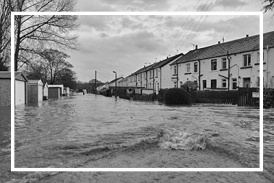House Raising vs. Shoring: Choosing the Right Solution for Structures in Flood-Prone Areas
Elwin Ordoyne, Vice President of E.C.O. Builders Inc. in Slidell, Louisiana, provides insight into the critical differences between these two techniques and when each should be considered.
“Each method serves a unique purpose,” said Ordoyne. “Understanding site-specific conditions—such as flood zone classification, soil stability, and existing foundation type—is key to determining which approach delivers the best long-term protection.”
House Raising: Elevation for Flood Mitigation
House raising is a structural lifting process in which the entire building is elevated above its existing foundation. This technique is commonly used in areas with high flood risk, particularly in FEMA-designated flood zones where elevation requirements are enforced through municipal building codes or grant-funded mitigation programs.
The house is typically lifted several feet above base flood elevation (BFE) using hydraulic jacks and temporary supports. A new, permanent foundation—often concrete piers, pilings, or block columns—is then constructed beneath the structure. This creates vertical clearance that allows water to pass beneath the home during flooding events, reducing the chance of water damage and lowering future insurance premiums.
House raising is typically recommended when:
The structure has sustained previous flood damage
Elevation requirements are necessary for compliance with local or FEMA floodplain regulations
The existing foundation is stable enough to support a lifting operation
The objective is to create significant clearance from future floodwaters
Shoring: Structural Stabilization and Leveling
Shoring, unlike house raising, is focused on foundation repair and stabilization rather than elevation. It is often used in response to uneven settling, foundation movement, or compromised footings due to poor soil conditions, erosion, or water intrusion.
In a shoring project, the house is temporarily supported while foundation elements are repaired, replaced, or leveled. Hydraulic jacks and cribbing are used to lift sagging sections of the home back to level, while new piers, pilings, or support beams are installed to reinforce the structure’s integrity.
Shoring is generally appropriate when:
The home shows signs of foundation settlement, cracks, or sloping floors
Flooding has caused soil displacement, but elevation is not required
The primary concern is structural stability rather than flood mitigation
Local building codes or elevation requirements do not mandate raising
Choosing the Right Solution Based on Risk and Condition
Determining whether house raising or shoring is the appropriate solution requires a full structural assessment, geotechnical review, and evaluation of flood zone status. In many cases, older homes built below base flood elevation in zones such as AE or VE will require elevation to comply with federal or municipal floodplain management requirements.
However, homes located in non-regulated flood zones may only require shoring to address damage caused by saturated soils or long-term erosion. Shoring offers a lower-cost alternative to elevation, especially when the home’s elevation is already compliant and flood mitigation is not a primary concern.
In cases where both elevation and structural settlement are present, a combination of shoring and house raising may be implemented. This ensures that the structure is level, stable, and compliant with applicable regulations.
Flood Insurance and Compliance Considerations
Elevating a home above base flood elevation can result in substantial savings on flood insurance premiums under the National Flood Insurance Program (NFIP). In contrast, homes that remain below BFE—even with structural improvements—may continue to face high premiums due to increased flood risk.
Property owners considering substantial renovations or post-storm repairs should evaluate whether lifting the home aligns with long-term cost savings and FEMA compliance standards. In many cases, elevation is not just recommended—it becomes required for substantial damage or improvement projects within high-risk zones.
Engineering, Permits, and Timing
Both house raising and shoring require engineering analysis, city or parish permits, and adherence to local building codes. House raising projects often involve coordination with surveyors, elevation certificate providers, and utility companies to disconnect and reconnect services.
Timing is also a factor, particularly during hurricane season or post-storm recovery periods when demand for mitigation and repair services increases. Proper planning, site evaluation, and contractor experience all play a role in ensuring the success of either approach.
Morgan Thomas
Rhino Digital, LLC
+1 504-875-5036
email us here
Visit us on social media:
Facebook
Legal Disclaimer:
EIN Presswire provides this news content "as is" without warranty of any kind. We do not accept any responsibility or liability for the accuracy, content, images, videos, licenses, completeness, legality, or reliability of the information contained in this article. If you have any complaints or copyright issues related to this article, kindly contact the author above.
Dr. Duane L. Dillard selected for The Lifetime Achievement Award by IAOTP
USA Today Bestselling Author DC Gomez to give away 1 million copies of Award-Winning e-book from April 2025 - April 2026
Legends of War - Book 2: Sparrow Wars in the Garden of Bliss, Presented by Atticus Publishing
Kalendarium
Więcej ważnych informacji
 Jedynka Newserii
Jedynka Newserii

 Jedynka Newserii
Jedynka Newserii

Prawo

UE lepiej przygotowana na reagowanie na klęski żywiołowe. Od czasu powodzi w Polsce pojawiło się wiele usprawnień
Na tereny dotknięte ubiegłoroczną powodzią od rządu trafiło ponad 4 mld zł. Pierwsze formy wsparcia, w tym zasiłki, pomoc materialna czy wsparcie dla przedsiębiorców, pojawiły się już w pierwszych dniach od wystąpienia kataklizmu. Do Polski ma też trafić 5 mld euro z Funduszu Spójności UE na likwidację skutków powodzi. Doświadczenia ostatnich lat powodują, że UE jest coraz lepiej przygotowana, by elastycznie reagować na występujące klęski żywiołowe.
Prawo
Rzecznik MŚP: Obniżenie składki zdrowotnej to nie jest szczyt marzeń. Ideałem byłby powrót do tego, co było przed Polskim Ładem

Podczas najbliższego posiedzenia, które odbędzie się 23 i 24 kwietnia, Senat ma się zająć ustawą o świadczeniach opieki zdrowotnej finansowanych ze środków publicznych. Zakłada ona korzystne zmiany w składkach zdrowotnych płaconych przez przedsiębiorców. Rzecznik MŚP apeluje do izby wyższej i prezydenta o przyjęcie i podpisanie nowych przepisów. Pojawiają się jednak głosy, że uprzywilejowują one właścicieli firm względem pracowników, a ponadto nie podlegały uzgodnieniom, konsultacjom i opiniowaniu.
Handel
Konsumpcja jaj w Polsce rośnie. Przy zakupie Polacy zwracają uwagę na to, z jakiego chowu pochodzą

Zarówno spożycie, jak i produkcja jaj w Polsce notują wzrosty. Znacząca większość konsumentów przy zakupie jajek zwraca uwagę na to, czy pochodzą one z chowu klatkowego. Polska jest jednym z liderów w produkcji i eksporcie jajek w UE, ale ma też wśród nich największy udział kur w chowie klatkowym. Oczekiwania konsumentów przyczyniają się powoli do zmiany tych statystyk.
Partner serwisu
Szkolenia

Akademia Newserii
Akademia Newserii to projekt, w ramach którego najlepsi polscy dziennikarze biznesowi, giełdowi oraz lifestylowi, a także szkoleniowcy z wieloletnim doświadczeniem dzielą się swoją wiedzą nt. pracy z mediami.




![Dramatyczna sytuacja w opiece długoterminowej. Kolejki oczekujących są coraz dłuższe [DEPESZA]](https://www.newseria.pl/files/1097841585/opieka-nfz-still-1,w_85,_small.jpg)





.gif)

 |
| |
| |
|